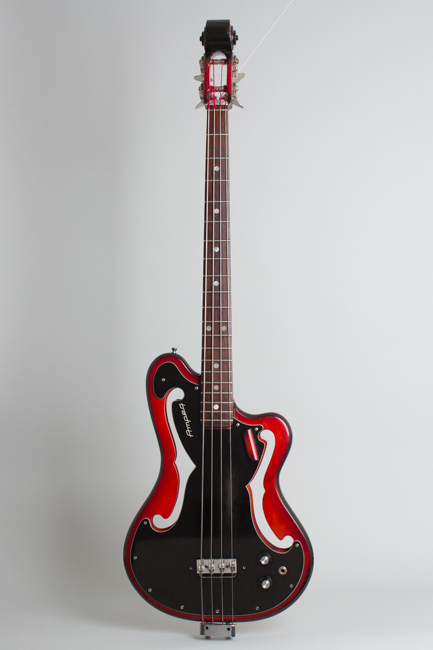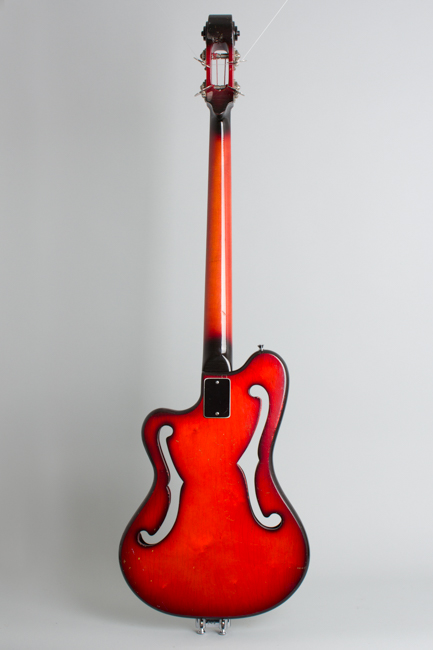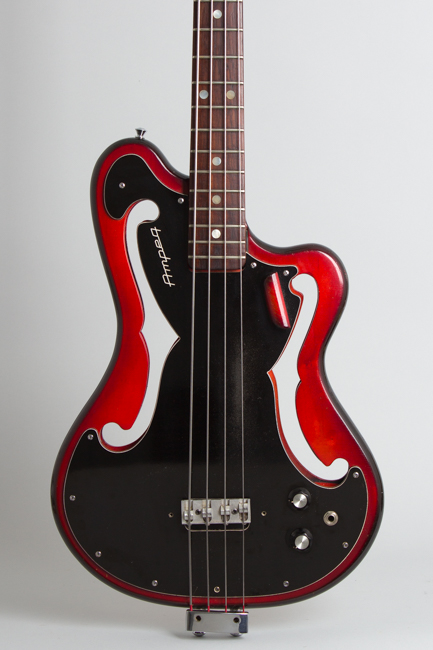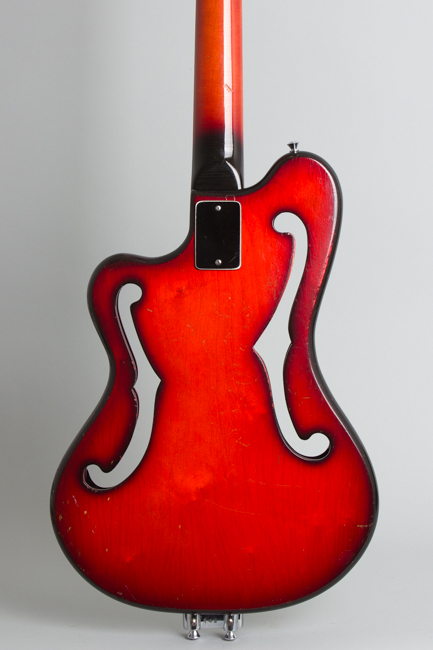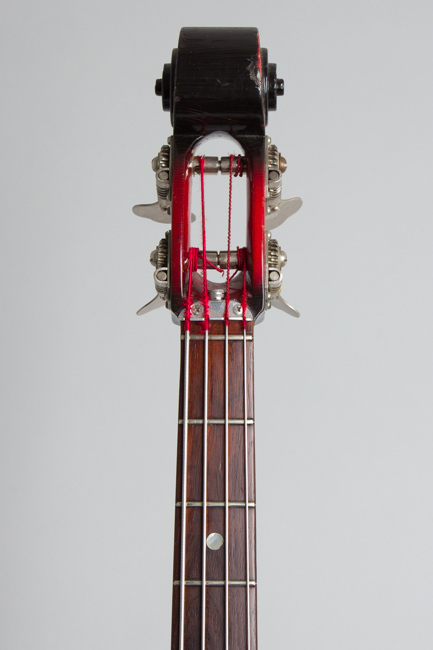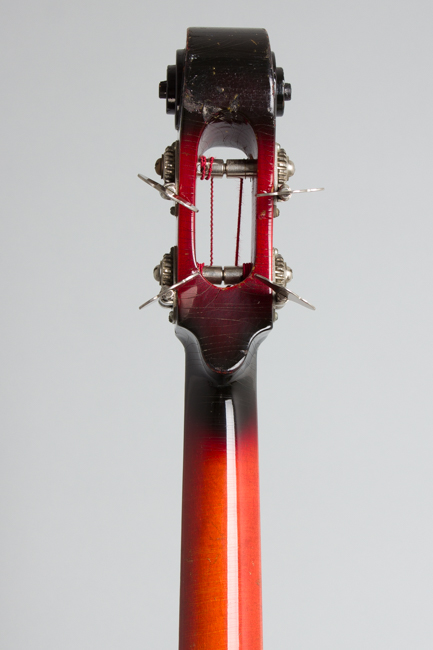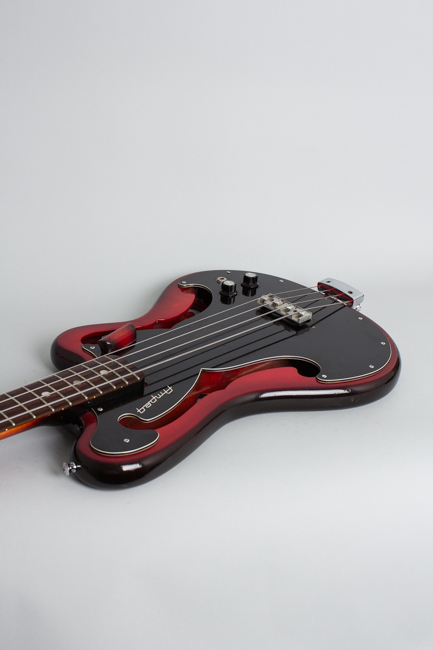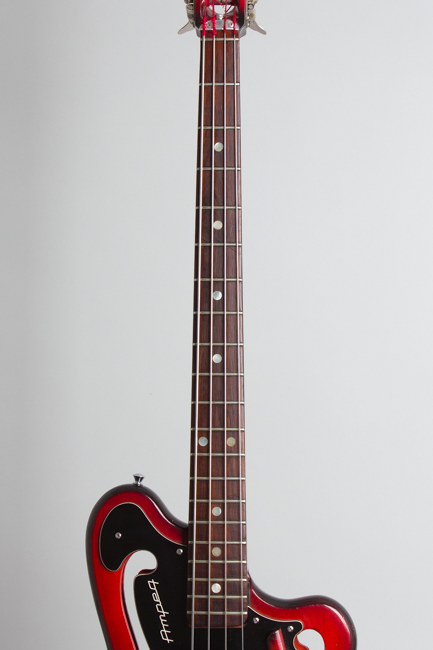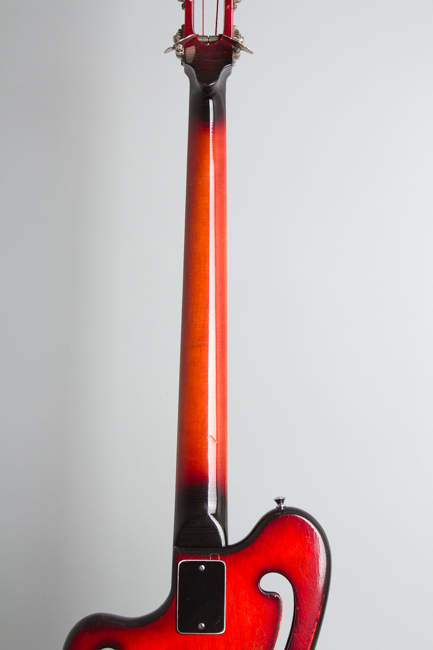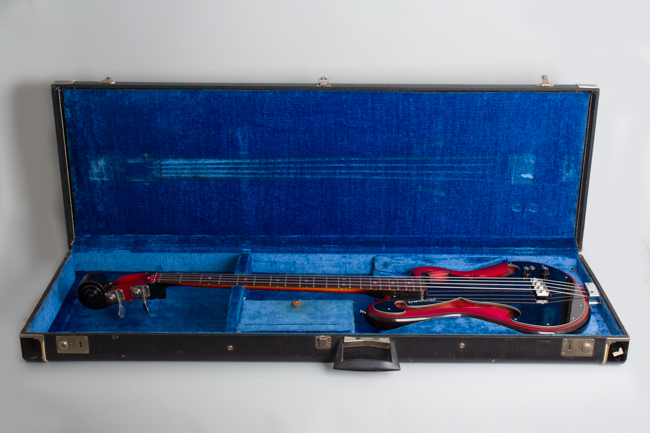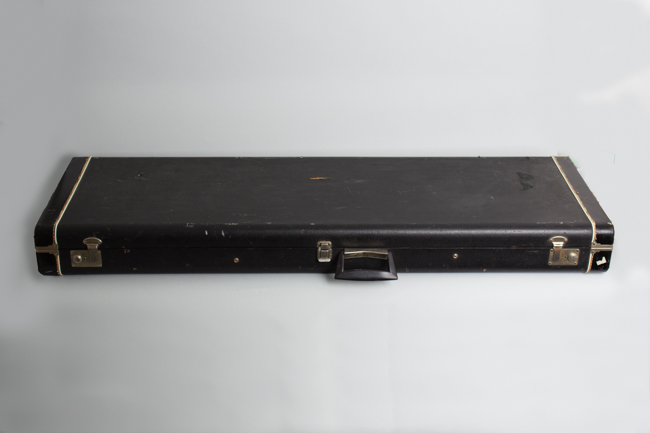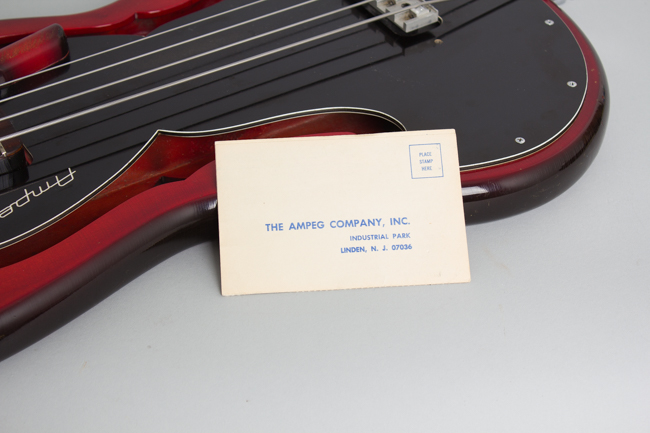Ampeg AEB-1 Electric Bass Guitar (1966)
Ampeg AEB-1 Model Electric Bass Guitar (1966), made in Linden NJ, serial # 149, red/black sunburst finish, laminated maple body, maple neck with ebony fingerboard, original black hard shell case.
This is a nice and very early example of the first version of Ampeg's AEB-1 (Ampeg Electric Bass #1), the so-called "horizontal" bass. While Ampeg prospered with amplifiers, they had previously made only half-hearted attempts to market instruments before 1966 with the fiberglass upright electric "Baby Bass" and briefly importing/re-branding Burns of London guitars. These unique Ampeg "scroll' basses were launched with some fanfare at the July 1966 NAMM show and have become something of a '60s classic, although never offering serious competition to the Fender Precision or Jazz bass.
The instruments were designed primarily by Ampeg employee Dennis Kager, but some features were the product of company founder Everett Hull's absolute distaste for the Fender bass. Hull was a purist who considered the upright bass to be the only legitimate low end instrument, and wanted to market an electric catering to traditional jazz and even classical players. To this end, this first Ampeg "Horizontal Bass" does not have a conventional magnetic pickup. Instead it utilizes the same design of vibration-activated "Mystery Pickup" located under the bridge as the upright Baby Bass, allowing use of gut strings as well as steel. This point Hull insisted on, much to the chagrin of his employees who knew rock'n'roll players were the major market. The unique scrolled headstock was another nod to bass fiddle tradition.
Ampeg had these instruments in production by September 1966, offering fretted and fretless models designated the AEB-1 and AUB-1. The bulk of production was from fall 1966 to the summer of '67, trailing off through late 1968. The fretless bass was a genuine innovation, designed to appeal to upright players transitioning to electric, the opposite of Fender's fretted "Precision". Unfortunately in the ever higher-volume playing environments of the late 1960s, the microphonic and fairly low output pickup proved rather impractical on stage. The instrument was re-designed in 1968 (after Hull sold the company!) to use a magnetic pickup, but sales never really picked up. Electronic oddities aside, the rest of the instrument is extremely well-engineered, nicely made and quite functional.
The unusual body is built of laminate woods; the most notable feature is the large open f-holes cut in either side. The maple neck has an ebony fingerboard inlaid with large dots and the infamous scroll headstock with side-mounted Kluson tuners. The bridge unit sitting over the pickup is made of milled aluminum and adjustable for height and intonation, with the strings running to a separate heavy tailpiece mounted off the bottom of the body. This setup requires special extra-long strings, although the scale length is the same as a Fender at 34". The serial number is stamped under the tailpiece bar; this early example carries #149.
We have seen a number of "Scroll" bass over the years but this both one of the earliest and best preserved we have had. These Ampegs offer a sound somewhere in between a standard bass guitar and an upright. The acoustic-y twang of the "mystery" unit can be mellowed using the volume and tone controls, but it does take some experience to understand how to get a variety of sounds from the instrument. This early model is better preserved than most and should be of interest to a player looking for a very "different' sound and feel or any collector of Ampegs and all vintage American basses.
Overall length is 47 in. (119.4 cm.), 14 1/2 in. (36.8 cm.) wide at lower bout, and 1 1/4 in. (3.2 cm.) in depth, measured at side of rim. Scale length is 34 1/2 in. (876 mm.). Width of nut is 1 5/8 in. (41 mm.).
This is a relatively clean and nicely original example of this fairly rare bass, the first mystery-pickup model. It has some typical finish checking on the body but is largely free of the cracking and flaking to the lacquer that often plagues these instruments. There is some minor chipping mostly along the lower body edge, and a few other spots around the rim; beyond that the bass shows only light play wear overall. The back has heavier checking and some areas of "strap burn" that visible are not too bad. The back of the neck is pretty clean except for a few small dings and dents and one deep ding behind the 11th fret. As usual the large scroll headstock has picked up its share of dings, dents and edgewear. There is a small chip of wood on the body glued back in just above one of the neck mounting screws.
All hardware remains original except the sliding bridge cover/mute bar, which is missing as most are. One bridge saddle length adjustment screw has been changed. This bass has some fret and fingerboard wear from roundwound strings but plays very well set up with the heavier flatwound strings that it likes better. The huge original hard shell case has some scuffing and wear but it intact and fully functional; these Ampegs will fit in nothing else! An original unused warranty card is in the pocket. This bass is eccentric-sounding for sure, but performs exactly as intended and is simply a superb example of this unique New Jersey creation. Overall Excellent - Condition.
This is a nice and very early example of the first version of Ampeg's AEB-1 (Ampeg Electric Bass #1), the so-called "horizontal" bass. While Ampeg prospered with amplifiers, they had previously made only half-hearted attempts to market instruments before 1966 with the fiberglass upright electric "Baby Bass" and briefly importing/re-branding Burns of London guitars. These unique Ampeg "scroll' basses were launched with some fanfare at the July 1966 NAMM show and have become something of a '60s classic, although never offering serious competition to the Fender Precision or Jazz bass.
The instruments were designed primarily by Ampeg employee Dennis Kager, but some features were the product of company founder Everett Hull's absolute distaste for the Fender bass. Hull was a purist who considered the upright bass to be the only legitimate low end instrument, and wanted to market an electric catering to traditional jazz and even classical players. To this end, this first Ampeg "Horizontal Bass" does not have a conventional magnetic pickup. Instead it utilizes the same design of vibration-activated "Mystery Pickup" located under the bridge as the upright Baby Bass, allowing use of gut strings as well as steel. This point Hull insisted on, much to the chagrin of his employees who knew rock'n'roll players were the major market. The unique scrolled headstock was another nod to bass fiddle tradition.
Ampeg had these instruments in production by September 1966, offering fretted and fretless models designated the AEB-1 and AUB-1. The bulk of production was from fall 1966 to the summer of '67, trailing off through late 1968. The fretless bass was a genuine innovation, designed to appeal to upright players transitioning to electric, the opposite of Fender's fretted "Precision". Unfortunately in the ever higher-volume playing environments of the late 1960s, the microphonic and fairly low output pickup proved rather impractical on stage. The instrument was re-designed in 1968 (after Hull sold the company!) to use a magnetic pickup, but sales never really picked up. Electronic oddities aside, the rest of the instrument is extremely well-engineered, nicely made and quite functional.
The unusual body is built of laminate woods; the most notable feature is the large open f-holes cut in either side. The maple neck has an ebony fingerboard inlaid with large dots and the infamous scroll headstock with side-mounted Kluson tuners. The bridge unit sitting over the pickup is made of milled aluminum and adjustable for height and intonation, with the strings running to a separate heavy tailpiece mounted off the bottom of the body. This setup requires special extra-long strings, although the scale length is the same as a Fender at 34". The serial number is stamped under the tailpiece bar; this early example carries #149.
We have seen a number of "Scroll" bass over the years but this both one of the earliest and best preserved we have had. These Ampegs offer a sound somewhere in between a standard bass guitar and an upright. The acoustic-y twang of the "mystery" unit can be mellowed using the volume and tone controls, but it does take some experience to understand how to get a variety of sounds from the instrument. This early model is better preserved than most and should be of interest to a player looking for a very "different' sound and feel or any collector of Ampegs and all vintage American basses.
Overall length is 47 in. (119.4 cm.), 14 1/2 in. (36.8 cm.) wide at lower bout, and 1 1/4 in. (3.2 cm.) in depth, measured at side of rim. Scale length is 34 1/2 in. (876 mm.). Width of nut is 1 5/8 in. (41 mm.).
This is a relatively clean and nicely original example of this fairly rare bass, the first mystery-pickup model. It has some typical finish checking on the body but is largely free of the cracking and flaking to the lacquer that often plagues these instruments. There is some minor chipping mostly along the lower body edge, and a few other spots around the rim; beyond that the bass shows only light play wear overall. The back has heavier checking and some areas of "strap burn" that visible are not too bad. The back of the neck is pretty clean except for a few small dings and dents and one deep ding behind the 11th fret. As usual the large scroll headstock has picked up its share of dings, dents and edgewear. There is a small chip of wood on the body glued back in just above one of the neck mounting screws.
All hardware remains original except the sliding bridge cover/mute bar, which is missing as most are. One bridge saddle length adjustment screw has been changed. This bass has some fret and fingerboard wear from roundwound strings but plays very well set up with the heavier flatwound strings that it likes better. The huge original hard shell case has some scuffing and wear but it intact and fully functional; these Ampegs will fit in nothing else! An original unused warranty card is in the pocket. This bass is eccentric-sounding for sure, but performs exactly as intended and is simply a superb example of this unique New Jersey creation. Overall Excellent - Condition.
